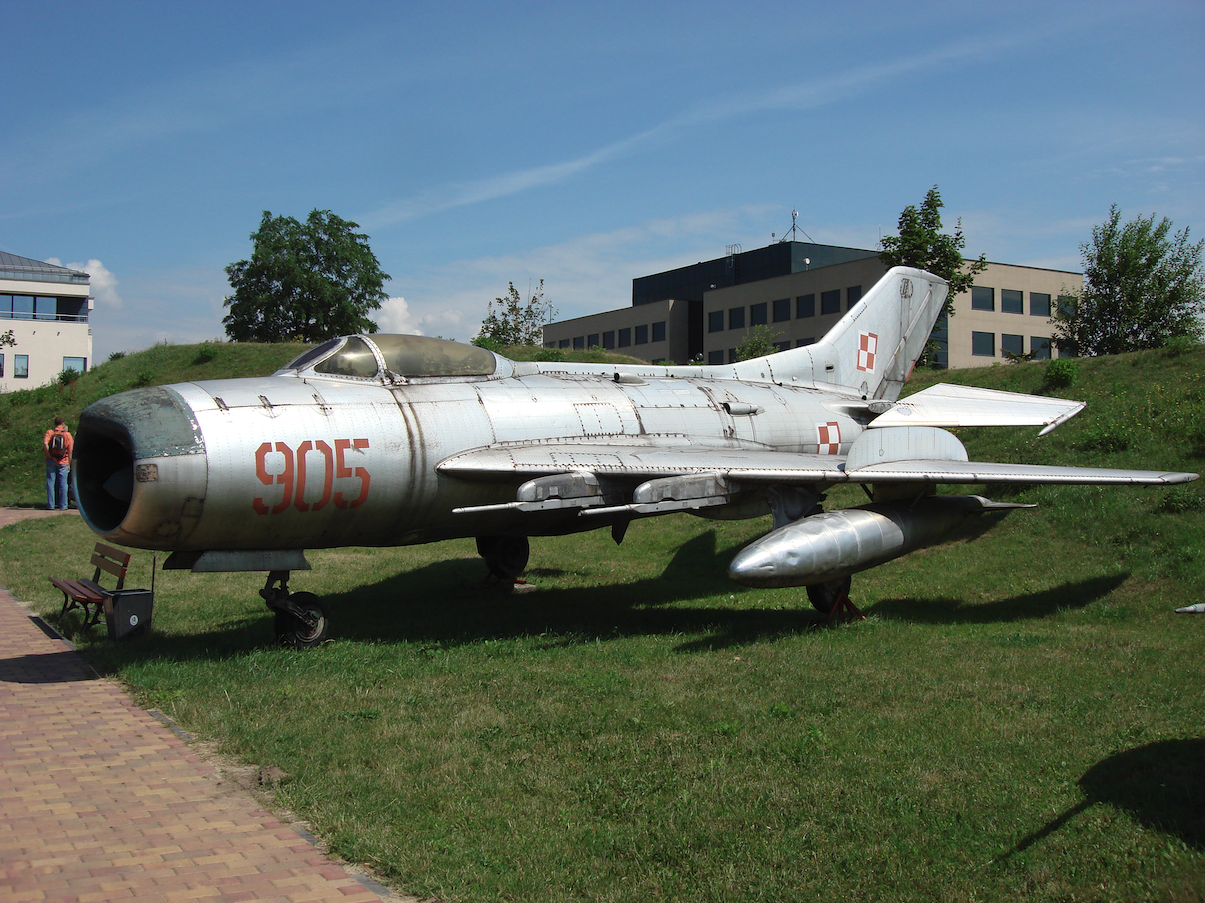Kraków 2007-07-07
153 Section 1957-12-03.
OKB Mikoyan and Gurevich MiG-19 P, PM.
History of the MiG-19.
In the Polish Army, the Mikoyan and Gurevich MiG-19 was the first supersonic fighter aircraft, and at the same time the first armed with guided air-to-air missiles.
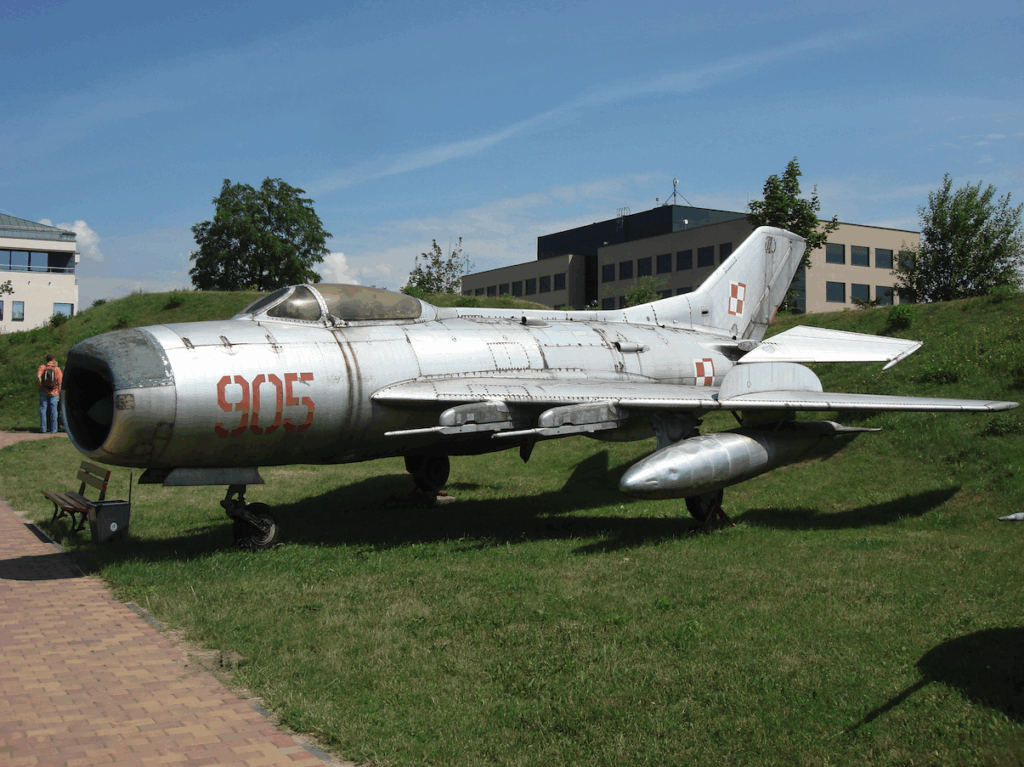
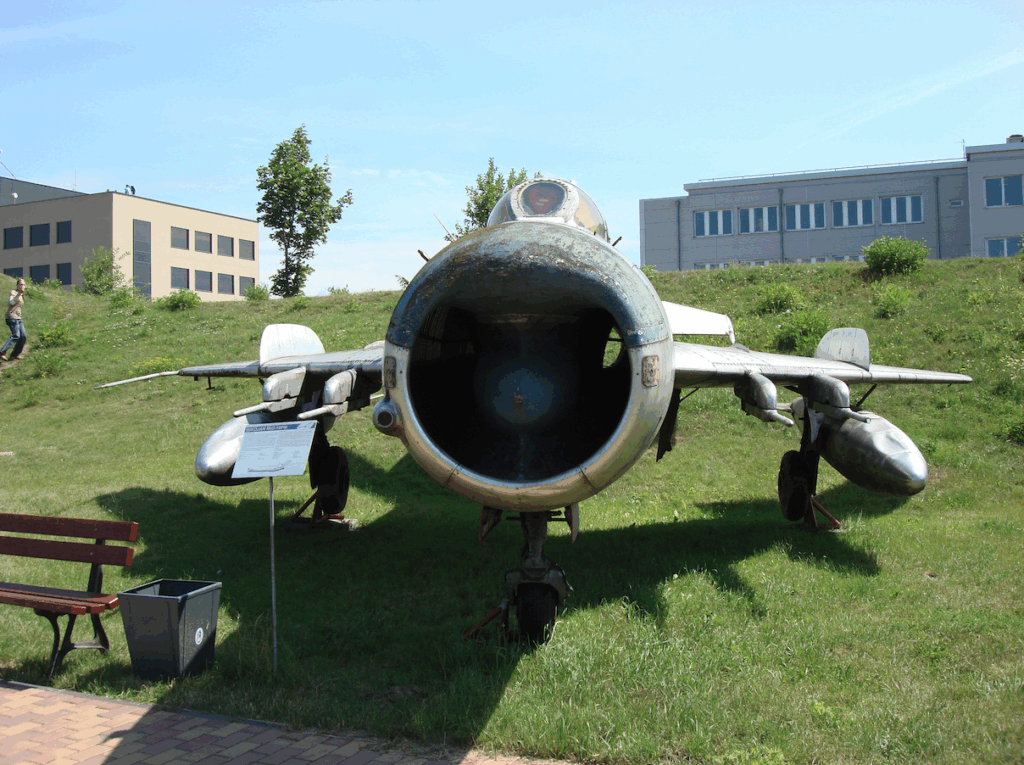
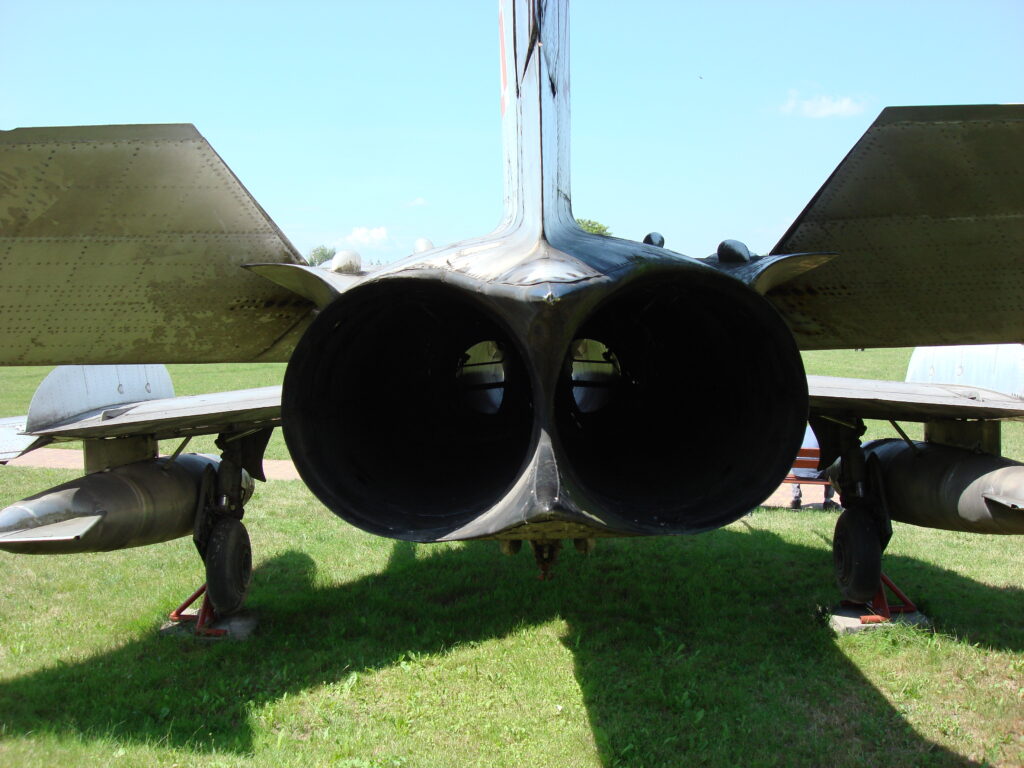
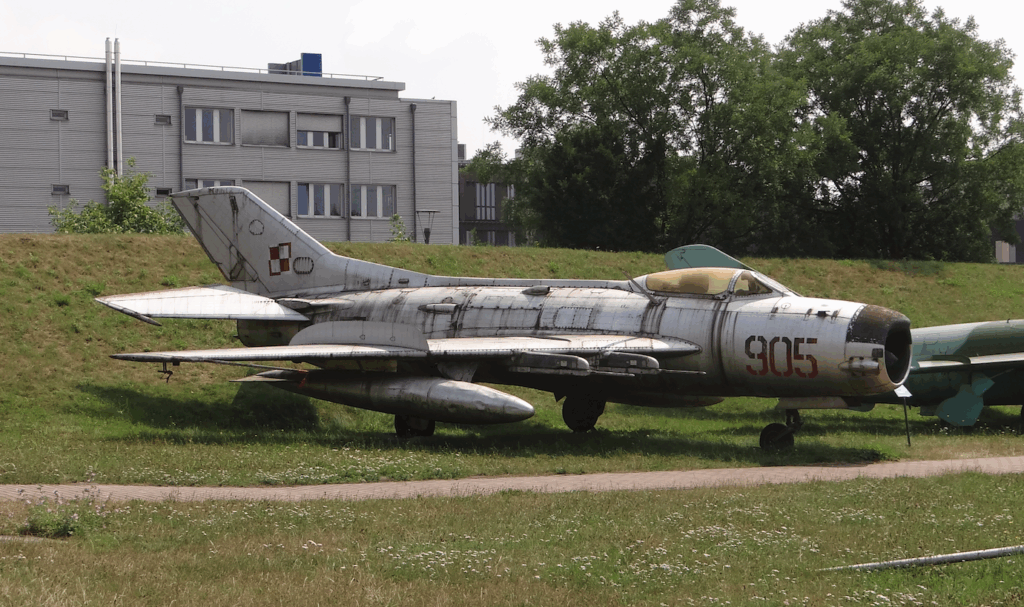
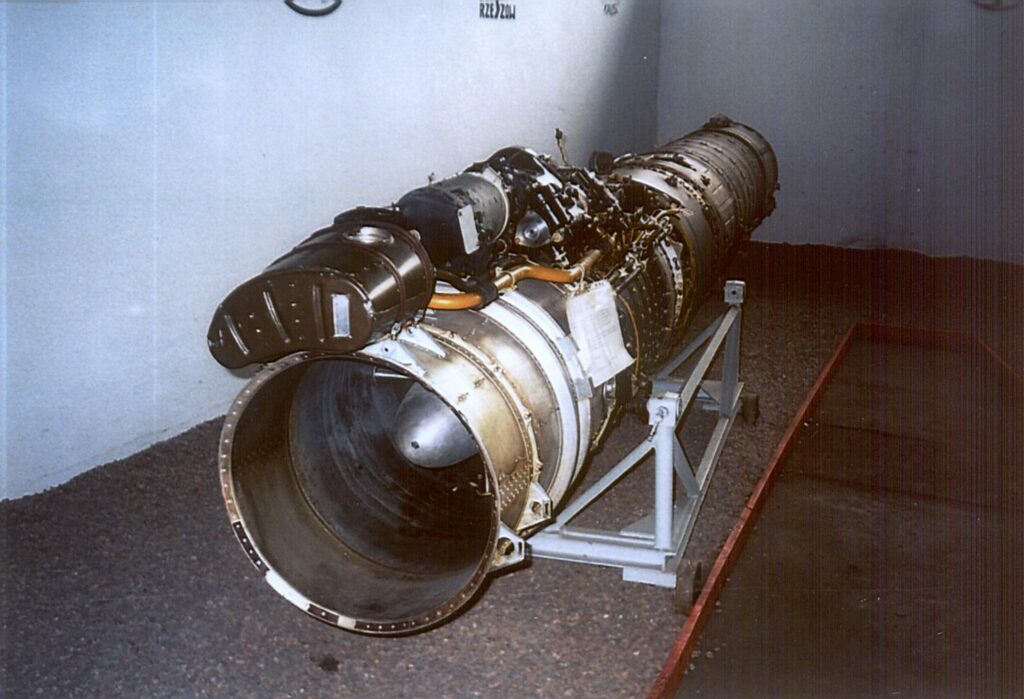
Mikoyan and Gurevich MiG-19. 1952.
The MiG-19 was not a logical continuation of the MiG-15 and MiG-17 fighters. It differed from them in almost everything. The only common features were the frontal air intake and swept wings. Most importantly, due to the twin-engine power unit and size, it belonged to heavy fighters, and its predecessors to medium ones. The MiG-19 was introduced into service on the express order of Moscow. This happened because the USAF began to introduce F-100 C fighters into service. The F-100 C aircraft had supersonic speed, and importantly, it was capable of carrying nuclear weapons. Moscow’s decision was to restore balance in the existing technology.
The Mikoyan and Gurevich OKB already had several designs capable of achieving supersonic speed. But there were problems with maintaining this speed continuously. The I-340 ( SM-1 ) and I-350 ( M ) designs should be mentioned here. The lack of a suitable turbojet engine was an obstacle. At this point, it is worth recalling the very promising TR-1 engine, which was associated with great hopes. However, the engine turned out to be a complete failure, which resulted in the collapse of several designs with expected supersonic speeds, such as the Sukhoi Su-17 (not to be confused with the later Sukhoi Su-17). On May 27, 1952, the I-360 ( SM-2 ) aircraft was flown. It was equipped with two A. Mikulin AM-5 engines with a thrust of 2 x 1,962 kgf. Although the engines were equipped with axial compressors and were promising, their too low thrust did not ensure flights at supersonic speeds. In addition, there were frequent failures. For example, turbine blades broke off.
Fortunately, an improved engine was developed, designated AM-9, with a thrust of 2 x 2,550 kgf. These engines allowed supersonic flights. The I-360 (SM-2) aircraft made 132 flights. G. Sedov piloted all of the flights.
And it was at this point that the Kremlin decided to introduce this design into service. They were aware of the design’s shortcomings, but there was no way out. Other designs in the CCCP were even more delayed.
The direct model for the MiG-19 production aircraft was the SM-9/1, which made its first flight on January 5, 1954. The design had many shortcomings. First of all, the tail proved ineffective in supersonic flight. Work was undertaken to introduce a plate-type tail. Work on it lasted throughout 1954. Another shortcoming was the lack of sufficient stability. This problem was solved only with the MiG-19 S version.
The test flights on the SM-9/1 were performed by pilots K. Kokinaki, Georgii Maslov and the nephew of the aircraft designer S. Mikoyan. At the same time, work on improving the engine did not cease. The work was led by S. Tumański, A. Mikulin’s successor. The engine received the production designation RD-9 and already had a thrust of 2 x 3 300 kgf with afterburning.
The production of the first version of the MiG-19 was very short. A small number of units were built, probably for propaganda reasons, because the aircraft still had many shortcomings. In July 1955, the MiG-19 aircraft was shown at the air parade in Tushino.
Shortly afterwards, the serial production of the MiG-19 S ( S – stabilizer ) aircraft began, derived from the SM-9/3 prototype. This design proved successful. Aircraft for various purposes were derived directly from this version. The MiG-19 SW ( W – high-altitude fighter ) was created in 1956. The MiG-19 R ( R – razvedchik ) reconnaissance aircraft and a short series of MiG-19 SF aircraft reaching a speed of 1,560 km/h. The second line of development consisted of aircraft built on the basis of the SM-7 prototype equipped with the RP-5 SR (radar), or more precisely, a radar sight. Thanks to this, new interceptors were created. The SM-7/2 prototype turned into the MiG-19 P ( P – perekhvatchik ) fighter. Then the MiG-19 PF was built. A version of the MiG-19 PG with the Gorizont-1 SR (radar) was also created, which was used to guide the aircraft to the target according to the indications of the ground command post. A short series of MiG-19 PU (U – uskoritiel) aircraft with additional rocket accelerators was also built.
The SM-7/2 M prototype was equipped with a new SR (radar) designated RP-2 U (Izumrud-2) and armed with 4 RS-2 U (K-5) ch.p.r. The aircraft was mass-produced under the designation MiG-19 PM (M – moddyfikowannyj). The same aircraft with the “Lazur” telemetry device was designated MiG-19 PMŁ.
The Mikoyan and Gurevich OKB also continued to develop the line of experimental SM aircraft, the purpose of which was to build a new fighter. Let us mention; SM-10 – air refueling, SM-12 – new air grabs, SM-30 – zero start, SM-50 – additional rocket engine.
The MiG-19 entered service with the Warsaw Pact countries; CCCP, Bulgaria, Czechoslovakia, the GDR, Poland, Romania and Hungary, as well as China, Egypt, Indonesia, Iraq, Pakistan, Syria and Cuba. Its production was undertaken in Czechoslovakia, but only the MiG-19 S version, i.e. without SR (radar), under the designation S-105. Production was also undertaken by China. Not only were aircraft manufactured there under license, but their own versions were also developed.
MiG-19 for Poland.
In the mid-1950s, it was already certain that the era of supersonic fighters was approaching irreversibly. The Polish Army already had very good Lim-5 fighters equipped with SR (radar), but they were not able to scare away NATO reconnaissance and reconnaissance aircraft in the form of U-2, Canberra PR and Atlantic machines quickly enough. These aircraft systematically violated Polish territory, mainly maritime ones. Therefore, a supersonic fighter capable of operating day and night would be a good solution. The first attempts to purchase supersonic aircraft by the Polish authorities were made in the second half of the 1950s. In July 1956 and January 1957, preliminary documents were signed providing for the licensed production of the MiG-19 fighter aircraft, under the designation Lim-7. However, the socio-political crisis in May 1957 in Poland caused an increase in distrust among the leaders in Moscow. Already during the preliminary talks in the Kremlin on May 24-25, 1957, Khrushchev declared that the CCCP would not, under any circumstances, transfer to Poland the rights to the license for the production of the MiG-19. We only obtained consent to purchase 33 MiG-19 machines in two versions; MiG-19 P with a radar sight and cannons and MiG-19 PM with a radar sight and RS-2 US guided missiles. It was planned to create three pursuit squadrons from these aircraft in the northern direction – in Słupsk, in the western direction – Poznań Krzesiny, in the southern direction – Mierzęcice.
There are discrepancies as to the exact number of aircraft. The most probable number is 33. The number 36 appears due to the so-called full-time workload. At that time, the fighter regiment was supposed to have 36 combat aircraft, not counting training and combat aircraft.
The MiG-19 P aircraft were brought in two deliveries. On December 3, 1957, 9 brand new aircraft arrived in Poland. On May 17, 1958, another 10 aircraft arrived. There were 14 MiG-19 PM aircraft and they were delivered at the turn of 1958/1959.
The first pilots selected for training on the new aircraft were: Capt. Czesław Kantyka and Capt. Zdzisław Mickiewicz. These pilots were trained in CCCP. They were probably the only pilots trained in CCCP. The rest were trained in Poland. The need to conduct training in Poland had already been seen earlier. Modlin was chosen as the training location. The new aircraft were initially located at the Modlin airport, where the Higher School of Pilots was formed. Pilot training at the Higher School of Pilots for the new equipment began in May 1958. The first systematic training of a group of 9 pilots was conducted by Capt. Czesław Kantyka.
At the beginning of 1959, the aircraft, in accordance with the plan, formed interceptor (pursuit) squadrons and achieved operational readiness. Interceptor squadrons were formed from the delivered aircraft, one each in the 28th PLM at the Słupsk-Redzikowo airport, the 62nd PLM based at the Poznań-Krzesiny airport and the 39th PLM at the Mierzęcice airport.
Versions used in Poland.
MiG-19 P (also known as aircraft 62) – the machine was equipped with a dual-antenna RP-5 radar. Above the inlet was a search antenna, in the bulkhead was a tracking antenna. The fuselage was extended by 0.9 m compared to the MiG-19 S version. The radar station forced a change in armament. To maintain the aircraft’s weight, the cannon was removed from the aircraft’s fuselage. Two 30 mm NR-30 cannons were left. Additionally, 2 pods with unguided rocket missiles were suspended.
MiG-19 PM (modified. Also known as aircraft 65) – this is an aircraft armed only with 4 K-5 (RS-2US) rocket missiles. The RP-5 radar station was replaced with the RP-2U (Izmrud-2), adapted to fire these missiles.
In the literature, you can find information that in addition to machines equipped with SR (radar), Poland also received MiG-19 S. They were mainly used to train pilots in flights on this type of fighter. However, no photo of this version in Polish colors can be found. There were only drawings. Also, none of the pilots confirm this information. Therefore, the information that Poland had the MiG-19 S version is unlikely, but not impossible. Two facts support this. Firstly, during the first negotiations with the Russian side, we could have been offered MiG-19 S aircraft, which is very likely, although this version did not satisfy us. Secondly, the MiG-19 S under the designation S-105 was produced by our neighbors, i.e. in Czechoslovakia. It is therefore not unrealistic that several units could have reached Poland in the second half of the 1960s.
Capt. Pilot Czesław Kantyka was the first Polish pilot to break the sound barrier in a MiG-19 P fighter during a show for the Ministry of National Defense (MON) command in the summer of 1958.
Lt. Pilot Roman Operacz was the first Polish pilot to break the sound barrier in a MiG-19 P fighter during a public show during a parade on July 22, 1959.
In 1959, pilot Roman Operacz experienced moments of emotion and terror. After performing periodic activities, the MiG-19 P took off into the air. During the maneuver at an altitude of 3,100 m and at a speed of about 1,000 km/h, the ammunition belt with the missiles broke and moved to the end of the wing. When the cannons were not in use, the ammunition belt was not fed into the chamber, but only attached to the hooks from which it broke. At the end of the wing, the belt cut the pressure relay and the relay changing the aircraft’s control depending on the speed. The elevator automatically switched from high speed to low, causing oversteering. A small movement of the stick caused either an almost vertical climb or a dive. Roman Operacz kept losing consciousness. The overloads were so great that the seat belts snapped and he hit his head on the canopy. He was thrown around the entire cabin. After regaining consciousness again, he noticed that he was flying below the treetops. Finally, he managed to reduce his speed. He sat in the cockpit, hunched over. He held the stick at its base, and the handle was at the height of his face. He landed safely. He was bruised, injured, and his eyes were bloodshot, but he was alive. He recovered in the hospital. Tests showed that the plane had been subjected to overloads from +10g to -5g. The plane had deformed wings and fuselage, but it did not fall apart.
62nd Fighter Aviation Regiment in Krzesiny.
In the period from May to September 1958, at the Higher School of Pilots in Modlin, pilots of the 62nd PLM participated in a course for training pilots for MiG-19 fighters: captains: Skrzydłowski and Góra and lieutenants: Makarewicz, Oczepko and Sobczyk (all from the first squadron). Technical services, previously part of the air squadrons, were excluded from them.
In the 62nd PLM, a technical division (DT) was formed, consisting of three technical squadrons, and a missile elaboration section (SER) was also established. The engineering section of the regiment was also subordinated to the commander of the technical division, with a subordinate technical service department, established in 1957. The command of the DT was assumed by the senior engineer of the regiment, Capt. Mieczysław Niedzielski.
MiG-19 P, PM aircraft were in the equipment of the 1st Squadron of the 62nd PLM until 1962. Since the regiment was selected to receive newer MiG-21 F-13 aircraft, the existing MiG-19 P, PM aircraft were transferred to the 28th PLM and 39th PLM.
39th Fighter Aviation Regiment in Mierzęcice.
MiG-19 P aircraft were in the equipment of the first squadron of the regiment since 1958. The number of MiG-19 P, PM aircraft in the regiment changed. The largest number of aircraft (max. 16) was in the regiment’s inventory after the transfer of some aircraft from the first squadron of the 62nd PLM.
In the spring of 1962, a group of several pilots left for CCCP for training in interception using RS-2 U guided missiles, which were equipped with MiG-19 PM. The entire group consisted of pilots from the command of WOPK, 28th PLM and 39th PLM, and included: Maj. pilot Czesław Kantyka – group commander, Capt. pilot Henryk Dańko, Lt. pilot Mieczysław Furmanek, Capt. pilot Bogusław Jaromin, Lt. pilot Wojciech Matonóg, Capt. pilot Zdzisław Skrzydłowski, Lt. pilot Władysław Waltoś and an officer of the armament service from WOPK. On July 1, 1965, the 39th PLM had: 5 MiG-19 PM, 9 MiG-19 P, 6 Lim-5, 13 Lim-2, 8 MiG-15 UTI, 2 TS-8 Bies and 1 An-2. On August 2, 1966, the 39th PLM suffered a plane crash. The regiment was relocated to an alternate airport in Kamień Śląski. The pilots were preparing for a night flight. The first to taxi out was Capt. Pilot Eugeniusz Nasiorowski, in a MiG-19 P nb 727. During takeoff (run), after 100-150 m, the aircraft experienced thrust asymmetry. The right engine was working at maximum thrust – “forcing”, and the left one only went to “maximum” or “nominal” (the accident commission was unable to determine this). The plane veered off the runway and glided along the grassy part of the airport straight into the stand filled with planes. The pilot, seeing the situation, fearing a collision with the planes, took off the machine. Too low speed caused the plane to fall from a height of 5-10 m onto the wing. At the moment of the fall, fuel spilled and an explosion occurred. The entire tragic situation was observed by other pilots of the squadron sitting in their planes prepared for take-off. Firefighters immediately started fighting the fire, trying to extinguish the burning plane, and also to prevent the fire from reaching the planes on the stand. Unfortunately, Capt. Pilot Nasiorowski died in the burning machine. During the service, the regiment transferred several MiG-19 P, PM planes to the 28th PLM. The withdrawal of MiG-19 fighters from the 39th PLM began in 1965. The last flights of the MiG-19 aircraft were carried out in May 1967. Also in May 1967, the last few aircraft were transferred to the 28th PLM.
28th Fighter Aviation Regiment in Słupsk – Redzikowo.
In 1958, the 28th Fighter Aviation Regiment began preparations for the introduction of MiG-19 aircraft. A group of pilots and technicians was selected and trained at the CCCP in Nowosiejka near Krasnodar.
The first MiG-19 P aircraft arrived at the 28th Fighter Aviation Regiment from Modlin in early December 1958. In July 1959, also from Modlin, 5 MiG-19 PM aircraft were delivered. The 1st Squadron was re-equipped with the new aircraft. The two remaining squadrons continued to fly Lim-2 and Lim-5 aircraft.
On 1 January 1962, the 28th PLM had: 5 MiG-19 PM, 7 MiG-19 P, 10 Lim-5, 7 Lim-2, 3 SBLim-1, 4 MiG-15 UTI and 4 TS-8 Bies.
On 15 September 1962, the regiment lost its first MiG-19 PM. Unfortunately, the pilot, Lt. Jan Drewicz, also died in the crash.
In October 1964, the 28th PLM had: 10 MiG-19 P, 5 MiG-19 PM, 8 Lim-5, 11 Lim-2, 3 SB Lim-1, 4 MiG-15 UTI and 4 TS-8 Bies.
In November 1965, another five MiG-19 PM were taken over from the 39th PLM in Mierzęcice. During 1966, several MiG-19Ps were also taken over from this regiment.
Unfortunately, in mid-1966, two MiG-19 PM aircraft were lost in accidents. The first aircraft crashed on June 20, 1966, near the town of Lulemino (pilot Major Raszewski survived). The second aircraft was lost exactly one month later, on July 20, 1966, in quite unusual circumstances. Second Lieutenant Pilot Zbigniew Kopacz, who was retraining for a new aircraft, accidentally activated the landing gear lever while still on the apron. The landing gear, loaded with the aircraft, did not retract immediately, but only during the take-off run. The aircraft began to scrape its nose against the runway, as a result of which it caught fire. The pilot managed to leave the cockpit, but the plane burned down MiG-19 PM nb 910.
On June 16, 1967, a winch failure occurred in a landing Il-28 bomber from the 19th Towing Squadron, which caused the “Gacek” towed on a too long rope to deviate from the runway axis to the right and completely smash the front part of the MiG-19 P nb 1012 standing in the grass.
In 1970, another disaster occurred, Lieutenant Władysław Raczkiewicz died while piloting the MiG-19 P – he did not manage to recover the plane from a dive during an attack on a ground target.
In 1970, the 28th PLM hosted a squadron of Hungarian MiG-19S (the Hungarians fired at surface targets), while in July 1972, a squadron of Słupsk MiG-19s was stationed at the Rybnitz-Damgarten airport in the GDR, where the Soviet 773rd PLM, which was equipped with MiG-21 PFM aircraft, was stationed.
On March 28, 1973, the on-duty pilot, Capt. Jan Budek, took off in a MiG-19 P to intercept an unidentified aircraft that had entered Polish airspace. After completing the task, he did not return to his home airport. Most likely, the aircraft fell into the Baltic Sea. The circumstances of the accident have not been explained.
On December 4, 1974, the last night flights of the MiG-19 aircraft took place. Parting ways with them was not without problems; the front landing gear failed to come out of the landing aircraft of Polt Major Boniface Trela.
In May 1975, the engines were removed from the withdrawn MiG-19 P and PM aircraft, which were sold to CCCP to be used to power La-17 flying targets. In June 1975, the dismantled fuselages of several aircraft were transported by road to the Nadarzyce training ground where, after reassembly, they served as targets. Four aircraft were preserved, one remained in the 28th Regiment MiG-19 PM nb 908, and two went to museums in Kołobrzeg MiG-19 P nb 728 and Kraków MiG-19 PM nb 905. The fourth aircraft was placed on a pedestal near the PKP railway station in Świdwin, but after some time, during a very strong gale, it fell and was scrapped. MiG-19 aircraft were demonstrated several times at air shows, usually in a group flight and individual piloting combined with exceeding the speed of sound at a high altitude.
Attempt to evaluate the MiG-19 aircraft.
The MiG-19 was the first supersonic aircraft in the Polish Air Force and, although it was used in small numbers, it allowed many pilots to learn the technique of flying at supersonic speeds. At the time of its introduction into service, the MiG-19 was the heaviest fighter aircraft in the Polish Army. It belongs to the group of heavy fighters. It was the first with a twin-engine drive. It had the highest thrust power, beating even the Il-28 bomber in this parameter.
A stereotype has been established in many publications that the MiG-19 was used in Poland for a short period. This is contradicted by the facts. The aircraft was introduced into service in 1957, and the last flights were performed in 1975, so 18 years of service cannot be considered a short period. The fact is that a successor quickly appeared in the form of the MiG-21 fighter. However, the first MiG-21s were in the MiG-21 F-13 version, i.e. without a radar sight (SR, radar), which limited its possibility of use at night and in bad weather. Therefore, the MiG-19 P, PM was superior to it. Only the appearance of the MiG-21 PF version changed the situation. Four Polish pilots died in crashes during service. In two cases, there was human error, in one engine failure, and one case is unknown to this day. In three other accidents, the pilots survived. In two of them, the pilot’s life was saved by an ejection seat, and in the third, the pilot landed.
Opracował Karol Placha Hetman

